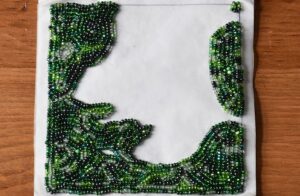Keeping connected and making histories in The Lake Nipissing Beading Project

By Kelly Anne Smith
NIPISSING FIRST NATION– A 5-metre long replica of Lake Nipissing is being created by beading artists of Dokis First Nation and Nipissing First Nation as part of The Lake Nipissing Beading Project.
The water of the lake, along with all of its tributaries and waterways, is being animated with glass beads.
Hosting the Speakers Series, Nipissing First Nation’s Suzanne Campeau Whiteduck explains, “We bead to show respect and acknowledge the importance of this waterway to those across the continent and the water shows us this.”
The Lake Nipissing Beading Project came together as part of a place-based partnership with Nipissing First Nation, Dokis First Nation, Nipissing University, and Anishinaabeg territory museums. It addresses the stress of disconnection during the COVID-19 global pandemic bringing people together virtually.
446 beading kits are available to order as that is the number of squares in the grid designed to cover Lake Nipissing and its surrounding waters.
Livestreamed presentations of beading artists, Elders, story and language keepers, and academics have been taking place since March of last year.
The final live stream in the Speakers Series of The Lake Nipissing Beading Project features Glenna Beaucage, Nipissing First Nation Manager of Culture and Heritage, and Katrina Srigley of Nipissing University. They have worked together on the history of Nbisiing lands and waterways for more than 11 years.
Hoping to generate relationships and stories, they explained images of Nbisiing beading examples, the artists and their histories. Beading art can mirror relationships to lands and waterways.
Katrina Srigley refines the purpose of the Lake Nipissing Beading Project.
“We understand the work we do together on the histories of the Nbiising Anishnabek as a process of what we’ve called animating Nbiising lands and waterways with stories.”
Srigley says the beading project engages in and establishes relationships through the act of creation and sharing.
“We use creation mindfully here to mean the making of something,” she says. “And as Craig Commanda put it so beautifully in his presentation on March 13, ‘Recreating and creating connections across generations to place, lands and waterways and to all our relations, including of course everyone listening this evening and in the future.'”
Srigley says there is an important reflection of dodem and pattern connected to family and community and nation in quilting as well as in regalia.
Glenna Beaucage points to Samantha Mianscum’s presentation in the Speakers Series.
“She spoke about beading the flower and berry patterns to reflect flowers from the territory we live in. The strawberry heart berry connects Samantha with her ancestors to Nbisiing territory, to the land. She recreates those relationships when she beads the strawberries and passes it on to her daughter Georgia.”
During the Speakers Series, Nipissing First Nation beading artist Amanda Bellefeuille talked of Mianscum’s father Dan Commanda as a gifted influential teacher for her. She was also taught by Brenda Lee, a Cree artist from Musquachees in Alberta. Bellefeuille is now passing the cultural art to her students at Nbisiing Secondary School.
In the presentation, Glenna Beaucage shows a photo of a toddler yoke she made for her granddaughter Destiny when she was four years old. She says her flowers are similar to ones beaded on moccasins by Josephine Beaucage.
Josephine Commanda Beaucage has been the inspiration of The Lake Nipissing Beading Project. Joan McLeod Shabogesic gave a presentation showing how Josephine Beaucage influenced and revitalized beading in our communities.
Glenna explains another pattern common in the 70s and 80s was the thunderbird.
“A lot of our medallions had a thunderbird pattern. It’s a pretty important symbol connecting us to spirit,” she recalls. “Beading and cultural arts, creating regalia, are an expression of visions and dreams. The colours and patterns they choose are not only for adornment but they are a display of identity, clans and spirit colours.”
Glenna informs that “Beading and cultural arts has served as healing for our people. We might start out as a simple sewing circle like we have at the Seniors Complex where we gather. Many times, the circle turns into a sharing circle. So, the beading circle is actually a vehicle to share other things and we help each other. I have been involved in many of these. Eventually, it turns into problem-solving.”
Glenna says beading brings all generations together and can provide the therapeutic space where cultural resilience is freely practiced.
“In creating regalia and cultural items–this can be very grounding and peaceful for an artist. It can be a place of prayer and meditation,” she explains. “I think of the people when I look at these images of the people who were classified as Sixties Scoopers or Residential School Survivors and how traumatic it was to have the culture and the freedom of cultural expression scrubbed from them. How liberating it must be now to create freely and express themselves.”
Organized by Carrie Allison and Nipissing University’s departments of Geography and History, in relationship with Nipissing First Nation and Dokis First Nation, The Lake Nipissing Beading Project is set to be exhibited in October in Halifax.
The 5-metre beading of Lake Nipissing and all of its waters will return to Anishinaabeg territory for a tour in the spring and summer of 2022.
The Lake Nipissing Beading Project is dedicated to educator, language keeper and Nipissing First Nation Deputy Chief Muriel-baa Sawyer.


